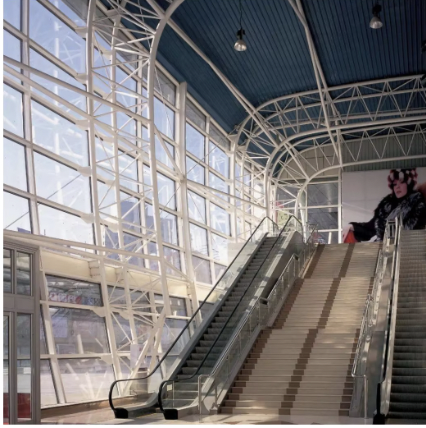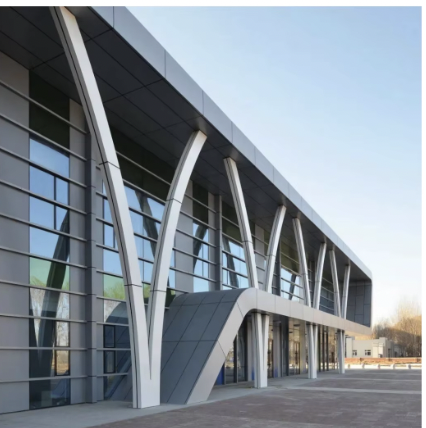TẠI SAO Công trình công nghiệp bằng thép Chiếm lĩnh Sản xuất Hiện đại
Sức mạnh Vô song và Độ chắc chắn Cấu trúc
Các tòa nhà khung thép là lựa chọn phổ biến trong ngành sản xuất hiện đại và các ngành công nghiệp khác nhờ độ bền, sức mạnh và sự ổn định vượt trội. Thép cũng là một vật liệu cấu trúc đa dụng, vì vậy một tòa nhà bằng thép cũng lý tưởng về khả năng kháng lực căng, bởi nó có thể chịu tải trọng lớn và tồn tại trong mọi môi trường khắc nghiệt. Thép có khả năng chịu được một lượng trọng lượng đáng kinh ngạc (lên đến 50.000 pound trên mỗi feet vuông, theo Viện Xây dựng Thép Mỹ), điều này cho thấy nó mạnh mẽ như thế nào. Khả năng hỗ trợ tải trọng nặng là lý do khiến các tòa nhà thép rất phù hợp cho không gian công nghiệp, vì máy móc và công cụ nặng yêu cầu nền móng vững chắc - nhà máy và xưởng sản xuất cần các tòa nhà có thể chịu được trọng lượng nặng của những máy móc này. Và vì các cấu trúc thép sẽ không bị cong vênh, co rút hoặc uốn cong, chúng có thể chịu đựng ngay cả những điều kiện môi trường tồi tệ nhất, và điều này rất quan trọng để đảm bảo an toàn và hiệu suất của hoạt động công nghiệp của bạn.
Khả năng thích ứng với nhu cầu công nghiệp đang thay đổi
Tính linh hoạt là một lợi thế chính khác của các tòa nhà có cấu trúc thép trong ngành công nghiệp sản xuất hiện đại. Các tòa nhà thương mại bằng thép có thể được tái cấu hình hoặc thậm chí mở rộng trong tương lai để đáp ứng nhu cầu kinh doanh thay đổi liên tục của bạn. Mức độ linh hoạt này có nghĩa là bố cục và cách vận hành không gian có thể tiến hóa theo yêu cầu sản xuất thay đổi, đáp ứng nhu cầu của từng ngành công nghiệp riêng biệt. Xây dựng bằng thép cũng rất linh hoạt vì nó có thể được thực hiện lại ngay lập tức để thích nghi với những thay đổi về diện tích sàn, bố cục hoặc bố trí máy móc mà không phải chịu chi phí cao như các phương pháp xây dựng truyền thống. Cuối cùng, khả năng thích ứng này có thể chuyển hóa thành tiết kiệm đáng kể chi phí trong suốt vòng đời, khiến các tòa nhà công nghiệp bằng thép trở thành lựa chọn hợp lý cho các ngành công nghiệp đang phát triển hoặc dự định thay đổi, thoát khỏi gánh nặng của việc phát triển cơ sở hạ tầng tốn kém có thể cản trở tiến trình.
Bằng cách thống trị sản xuất hiện đại, các tòa nhà kết cấu thép chứng minh rằng sức mạnh vượt trội, tính toàn vẹn về cấu trúc và khả năng thích ứng của chúng là sự lựa chọn hoàn hảo cho cảnh quan công nghiệp đang thay đổi. Khả năng cung cấp những lợi ích này khiến chúng trở thành lựa chọn ưu tiên so với các phương pháp xây dựng truyền thống, định vị chúng như những người dẫn đầu trong việc xây dựng cơ sở công nghiệp.
Tối ưu hóa quy trình công nghiệp với thiết kế rộng rãi
Tạo ra các bản vẽ mặt bằng không có chướng ngại vật
Hai phần của kết cấu cầu là một phần của yếu tố phân tích hiệu quả các bản vẽ mặt bằng trong các nhà xưởng công nghiệp. Những thiết kế như vậy loại bỏ nhu cầu về cột nội thất, tăng cường việc sử dụng không gian sàn cho nhiều hoạt động sản xuất khác nhau. Thiết kế mở này cho phép đạt được tính năng tối đa cũng như tạo ra môi trường làm việc an toàn và dễ tiếp cận. Quy trình làm việc hiệu quả được hỗ trợ bởi sự di chuyển dễ dàng của con người và vật liệu. Thực tế, số liệu cho thấy rằng các doanh nghiệp sử dụng không gian mở có thể tăng năng suất lên tới 30%, khẳng định tầm quan trọng của thiết kế nhịp rộng trong các môi trường công nghiệp đương đại.
Tăng cường xử lý vật liệu và quy trình làm việc
Các tòa nhà thép đặc biệt phù hợp để cải thiện việc xử lý vật liệu và dòng chảy của công việc. Chúng cung cấp thiết bị hàng đầu và các điểm chuyển đổi để đảm bảo dòng chảy vật liệu tốt nhất có thể trong suốt kế hoạch. Sự kết hợp hiệu quả này rút ngắn thời gian vận chuyển và giảm thiểu các điểm nghẽn thường gặp trong quá trình sản xuất. Ngoài ra, cơ sở hạ tầng thông minh dựa trên thép có tiềm năng tăng năng suất lên đến 25% và thậm chí hơn nữa nếu các khái niệm quy trình làm việc thông minh được áp dụng. Việc áp dụng các thiết kế mới này mang lại sự đơn giản hóa hoạt động và phản ứng nhanh hơn với các biến động và thay đổi trong yêu cầu sản xuất.
Khả Năng Tải Trọng Siêu Nặng Cho Hoạt Động Công Nghiệp
Hỗ Trợ Máy Móc Và Thiết Bị Nặng
Chính là các cấu trúc thép không thể thiếu để đạt được khả năng chịu tải cần thiết để hỗ trợ máy móc/thiết bị nặng trong môi trường công nghiệp. Mức độ bền này có tầm quan trọng then chốt đối với các doanh nghiệp sử dụng máy móc và thiết bị nặng (nhiều trong số đó thuộc các ngành khai thác, xây dựng và sản xuất). Trong những môi trường như vậy, sự toàn vẹn của các tòa nhà thép là rất quan trọng để tránh mọi mối đe dọa về an ninh và năng suất do nguy cơ thất bại hoặc hư hại tiềm ẩn. Các hệ thống kỹ thuật thường chỉ ra rằng việc xây dựng bằng thép chất lượng cao có thể dễ dàng quản lý đủ tải trọng hơn so với các phần đã cuộn, cung cấp một nơi làm việc tốt hơn.
Tích hợp Hệ thống Cẩu và Nâng Hạ Trên Không
Hệ thống cần cẩu tương thích với các tòa nhà thép, đồng thời cung cấp thêm chức năng công nghiệp thông qua việc xử lý vật liệu theo chiều dọc. Việc tích hợp hệ thống cần cẩu vào khung kết cấu giúp giảm thời gian bốc dỡ hàng hóa, mang lại lợi ích về thời gian, điều này rất quan trọng đối với các cơ sở công nghiệp bận rộn. Ngoài ra, các hệ thống nâng hạ trên cao cải thiện đáng kể độ an toàn trong khi làm việc bằng cách giảm thiểu việc xử lý thủ công, vốn là nguyên nhân chính gây ra chấn thương liên quan đến công việc. Với những cơ chế như vậy sẵn có cho doanh nghiệp, họ có thể tối đa hóa năng suất trong khi giảm thiểu nguy cơ căng thẳng và chấn thương cho người lao động.
Xây dựng nhanh chóng để hạn chế gián đoạn hoạt động
Các thành phần được thiết kế sẵn cho việc lắp ráp nhanh
Việc áp dụng các cấu trúc thép tiền chế đã đẩy nhanh tiến độ xây dựng nhờ hiệu quả về thời gian. Các bộ phận này được sản xuất với kích thước chính xác trước và lắp ráp nhanh chóng tại hiện trường, đôi khi chỉ trong vài tuần thay vì vài tháng. Nghiên cứu đã chứng minh hiệu quả của phương pháp này và phát hiện rằng chi phí nhân công có thể giảm tới 20%, đây là một khoản tiết kiệm lớn cho các công ty muốn kiểm soát chi phí nhưng vẫn tăng tốc độ xây dựng. Độ chính xác và độ bền của các bộ phận đã cắt sẵn giúp bạn tiết kiệm thời gian và tiền bạc đồng thời đảm bảo rằng tòa nhà công nghiệp của bạn mạnh mẽ và bền bỉ - những lợi thế này khiến chúng trở thành một phần quan trọng trong thế giới xây dựng công nghiệp đang phát triển nhanh chóng.
Tối ưu hóa việc mở rộng và cải tạo nhà máy
Với các cấu trúc thép, bạn có thể dễ dàng thực hiện các phụ kiện hoặc sửa đổi mà không gây gián đoạn nhiều đến hoạt động kinh doanh tổng thể. Sự linh hoạt này cho phép các doanh nghiệp giữ lại 90% khả năng vận hành, trong khi vẫn hoàn thành các dự án xây dựng quy mô lớn - một lợi thế quan trọng trong các ngành mà thời gian ngừng hoạt động đồng nghĩa với việc mất đi doanh thu đáng kể. Những lời chứng thực từ một số công ty khẳng định rằng các thực hành hiệu quả của xây dựng bằng thép là những yếu tố then chốt để đạt được sự liên tục trong hoạt động. Sự đa dạng của các tòa nhà thép cho phép chúng dễ dàng được sắp xếp lại hoặc mở rộng theo nhu cầu kinh doanh, làm cho chúng trở thành giải pháp lý tưởng cho các yêu cầu công nghiệp thay đổi.
Hiệu quả Năng lượng và Giải pháp Kiểm soát Khí hậu
Kỹ thuật Cách nhiệt Tiên tiến
Các tòa nhà bằng thép còn mang lại nhiều lợi ích khác khi có cơ hội tận dụng vật liệu cách nhiệt hiệu quả nhất và các giải pháp tiết kiệm năng lượng. Với sự trợ giúp của vật liệu cách nhiệt hiện đại, những tòa nhà này duy trì nhiệt độ nội bộ ổn định, điều này rất quan trọng đối với các quy trình sản xuất nhạy cảm. Theo nghiên cứu, bạn có thể tiết kiệm được 30-40% năng lượng nhiều hơn so với các phương pháp truyền thống nhờ cách nhiệt tốt hơn. Hơn nữa, việc giảm tiêu thụ năng lượng không chỉ làm giảm chi phí HVAC mà còn tăng tổng số tiết kiệm năng lượng của tòa nhà. Việc áp dụng các phương pháp này trong các tòa nhà cấu trúc thép đảm bảo công việc được thực hiện suôn sẻ mà không bị gián đoạn bởi sự chênh lệch nhiệt độ, đồng thời góp phần cải thiện hiệu suất chi phí và sự ổn định trong sản xuất.
Quản lý Nhiệt Độ Bền vững
Việc đảm bảo rằng các bộ phận của tòa nhà thép không dẫn nhiệt hoặc đóng băng là điều quan trọng để giảm chi phí. Các tòa nhà thép, thông qua các hệ thống tinh vi, có thể điều chỉnh môi trường bên trong theo điều kiện bên ngoài và mức độ sử dụng. Cách vận hành này tiết kiệm năng lượng vì sưởi ấm hoặc làm mát chỉ được áp dụng khi cần thiết. Những hệ thống thông minh này giảm đáng kể chi phí vận hành và tối ưu hóa hơn nữa tính bền vững tổng thể, theo xu hướng sản xuất công nghiệp thân thiện với môi trường. Những thực hành này không chỉ tốt cho hành tinh bằng cách tiết kiệm năng lượng, mà còn tốt cho lợi nhuận của công ty bằng cách giảm chi phí sử dụng năng lượng không cần thiết.
Hiệu quả Chi phí và Độ bền Dài hạn
Giảm Chi phí Bảo trì và Vận hành
Các tòa nhà thép cực kỳ hiệu quả về chi phí, vì chúng thường rẻ hơn để bảo trì so với các loại tòa nhà khác. Khả năng chống gỉ và mục của thép mang lại tuổi thọ sử dụng chưa từng có, dẫn đến bề mặt mài mòn lâu hơn và ít bảo trì hơn, cuối cùng tiết kiệm thời gian và tiền bạc. Các báo cáo ngành cho thấy trong suốt vòng đời của mình, các tòa nhà thép có thể tiết kiệm khoảng 25% chi phí bảo trì. Điều này là do độ bền đi kèm với một tòa nhà thép, vì vậy bạn có thể tự tin rằng bạn đang thực hiện một khoản đầu tư thông minh cho doanh nghiệp của mình và đó là một khoản sẽ tiết kiệm tiền theo thời gian. Khi chọn thép, các doanh nghiệp không chỉ tiết kiệm chi phí bảo trì mà còn yên tâm biết rằng khoản đầu tư của họ được đảm bảo lâu dài.

Giá trị chu kỳ sống và lợi thế tái chế
Chi phí vòng đời của các tòa nhà kim loại cũng là một yếu tố rất hấp dẫn về mặt kinh tế và môi trường. Được xây dựng để tồn tại qua nhiều thế hệ với mức độ xuống cấp thấp, các cấu trúc thép cung cấp những lợi thế bền vững không thể phủ nhận. Ngoài tuổi thọ tuyệt vời, khả năng tái chế của thép là một lợi thế lớn. Thép có thể tái chế 100%, vì vậy nó cũng rất phù hợp với các mục tiêu doanh nghiệp hướng tới việc giảm tác động môi trường và tăng tính bền vững. Và các nghiên cứu cũng chỉ ra rằng việc tái chế thép cực kỳ tiết kiệm năng lượng, chỉ tiêu thụ 25% năng lượng so với việc sản xuất thép mới. Hiệu quả này giúp giảm sử dụng năng lượng và thúc đẩy nền kinh tế tuần hoàn – biến nó thành một giải pháp bất động sản cho các doanh nghiệp.
Phần Câu hỏi Thường gặp
Tại sao các tòa nhà công nghiệp bằng kết cấu thép lại phù hợp cho sản xuất?
Các tòa nhà công nghiệp bằng kết cấu thép rất phù hợp cho sản xuất nhờ độ bền, khả năng thích ứng và khả năng hỗ trợ thiết kế rộng rãi mà không cần cột trong, tối ưu hóa không gian sàn và hiệu quả quy trình làm việc.
Tòa nhà thép đóng góp vào hiệu quả năng lượng như thế nào?
Các tòa nhà thép tăng cường hiệu quả năng lượng thông qua các kỹ thuật cách nhiệt tiên tiến và hệ thống quản lý nhiệt độ bền vững, duy trì nhiệt độ nội bộ ổn định và giảm tiêu thụ năng lượng.
Tại sao các thành phần thép được thiết kế trước lại có lợi?
Các thành phần thép được thiết kế trước rút ngắn thời gian xây dựng và chi phí nhân công đồng thời đảm bảo độ chính xác và độ bền, khiến chúng trở nên lý tưởng cho việc phát triển nhanh chóng các cơ sở công nghiệp.
Mục Lục
- TẠI SAO Công trình công nghiệp bằng thép Chiếm lĩnh Sản xuất Hiện đại
- Tối ưu hóa quy trình công nghiệp với thiết kế rộng rãi
- Khả Năng Tải Trọng Siêu Nặng Cho Hoạt Động Công Nghiệp
- Xây dựng nhanh chóng để hạn chế gián đoạn hoạt động
- Hiệu quả Năng lượng và Giải pháp Kiểm soát Khí hậu
- Hiệu quả Chi phí và Độ bền Dài hạn
- Phần Câu hỏi Thường gặp






